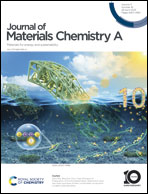A 3D printed alveolus-inspired flow field for direct methanol fuel cells with enhanced performance and durability†
Abstract
The vapor-fed passive DMFC is highly energy-dense, environmentally friendly, and noise-free. However, controlling the internal environment of the DMFC, especially temperature and humidity, is challenging due to the lack of heat/water management system. To address this issue, we propose an alveolus-inspired flow field in the DMFC cathode, which is 3D printed to maintain the internal environment similar to that of alveolus. Our findings show that the alveolus-inspired flow fields with upward and leftward pores exhibit higher and more stable DMFC performance (20.3 mW cm−2), which is 2.2 times that of the traditional DMFC. This is due to the similar characteristics of the alveolus in the lung, which maintains an excellent and stable internal environment with higher humidity and temperature (compared to traditional DMFC increases of greater than 10 °C). Moreover, as the partially open chambers are similar to those in the alveolus, the biomimetic DMFC can resist harsh weather conditions such as strong winds, sand, and dust. Specifically, after sand and dust treatment, the performance of the biomimetic DMFC decreased only by 16.6%, while that of the traditional DMFC sharply decreased by 66.6%. This alveolus-inspired flow field can be applied to other air-breathing fuel cells or batteries, such as hydrogen–air fuel cells, zinc–air batteries, lithium–air batteries, etc., to improve their performance, stability, and harsh weather resistance.



 Please wait while we load your content...
Please wait while we load your content...